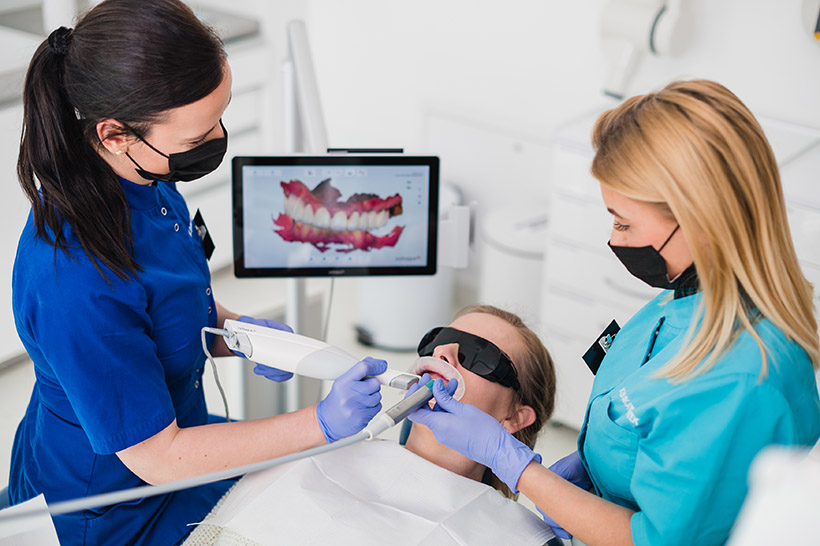Digital Dentistry

Digital Smile Design
Modern technologies in dentistry allow for treatment at the highest level. The use of an intraoral scanner, which accurately reads the conditions in the patient's oral cavity, creating a three-dimensional image of the dentition on the monitor, has a huge impact on the quality of treatment. It is a part of the CAD/CAM system (computer-aided design/computer-aided manufacturing), which allows for the prosthetic restoration to be made on-site and during a single visit.
At the Kwiatek Clinic in Poznań, patients can enjoy excellent treatment results using ultra-modern prosthetic systems: CAD/CAM, 3Shape.
Digital prosthetics is one of the greatest achievements of contemporary dentistry. It is a rapidly developing branch of dentistry that uses the latest technical achievements to design and perform prosthetic work in virtual reality.
What are the advantages of digital prosthetics?
Without impression
Until now, during the preparations for making a crown, bridge, veneer or fillings after root canal treatment, dentists used impression material. This method often caused discomfort for the patient and, above all, was less accurate than scanning.
Thanks to the intraoral scanner, the dentition is digitally recorded, and its image immediately appears on the computer screen in three dimensions. This allows the doctor to conduct a virtual simulation and show the patient what the specific filling will look like in the final result.
Without metal
The future of dentistry lies in prosthetic work without a metal substructure. They guarantee high aesthetics, absence of galvanic cells and sensitivities.
With the use of a scanner and the CAD/CAM system, full-ceramic restorations (crowns, bridges, overlays, veneers), zirconia restorations, and highly aesthetic temporary fillings can be made.
Maximum precision
One of the significant advantages of the scanner is the elimination of human error, inherent in our nature. With its use, the quality of the impression taken is instantly verified by the computer. In case of any errors, the software verifies the data and rejects the image that does not guarantee precise execution of prosthetic work.
Colourful 3D images allow the doctor to easily define the boundaries of preparation and determine the differences between the natural structure of the tooth and the filling. This makes the planned reconstruction more accurate. Such image precision is not achievable with traditional methods. The processing is done with an accuracy of up to 0.2 micrometres!
The high accuracy of the scanner allows for better clinical results and increased durability of fillings. Crowns, bridges, veneers are tightly fitted to the surface of the teeth, thereby reducing the risk of developing bacteria causing secondary caries.
High durability
Digital crowns, bridges or veneers from a computer are of higher quality than traditional fillings, and digitally designed prosthetic works guarantee predictability and durability.
Who is CAD/CAM prosthetics intended for?
Digital dentistry meets the needs of patients who value high-quality prosthetic fillings, fully customized and naturally looking.
Significant relief will be felt by those for whom taking traditional impressions was burdensome and associated with unpleasant sensations. The use of the CEREC or 3Shape system allows to eliminate the discomfort associated with traditional prosthetics.
What does the creation of teeth look like in the CAD/CAM system?
Intraoral scanning is fully comfortable for the patient. The camera takes a series of photos, from which it creates a three-dimensional image of the oral cavity. The process itself takes a few minutes.
Then, based on the data, a prosthetic supplement is designed. The model can be viewed from all sides and corrected if necessary. The creation of the prosthetic work is supervised by a doctor, who can determine, among other things, the height and position of the tooth, contact points or the depth of grooves.
The project is sent to a milling machine, which cuts out a crown, bridge or veneer from the highest quality material. The base color of the tooth can be additionally characterized at the moment of setting the work, if it is necessary to ensure the best aesthetics.
Not just prosthetics
The CAD/CAM software is also used in other fields of dentistry. Orthodontics and implantology are examples of specializations that also utilize the capabilities of digital systems.
Teeth in One Day
At Kwiatek Clinic, we prioritize technological advancement and continuous improvement. We understand that the future of dentistry is inextricably linked to digitization and we follow this trend. Once again, modern technology shows how effectively and quickly it complements human work. The intraoral scanner is the best example of this.
It thus guarantees benefits for the Patient: prosthetic work of the highest quality, with exceptional precision of adaptation to the conditions in the oral cavity, fewer visits, and full comfort during scanning by eliminating impression procedures.
Prosthodontists
Price List
Prosthodontics
|
Prosthetic consultation 300 zł
Before undertaking prosthetic treatment, the doctor analyzes X-ray images and diagnostic models, and performs a computer smile analysis. Thanks to this, they can create a DSD (Digital Smile Design) project, which shows the final effect of the treatment even before it begins. |
|
Full ceramic crown 2 800 zł
Full-ceramic crown of the highest quality - cemented onto a previously prepared tooth. It strengthens its structure, and thanks to the digital design, it ensures a "cinematic" aesthetics. |
|
Ceramic Veneer 3 000 zł
Ultra-thin, porcelain "flakes" are applied to a minimally prepared tooth. This allows us to achieve an excellent aesthetic effect with minimal (up to 0.5 mm) interference in the patient's tissue. |
|
ONLAY, INLAY, OVERLAY 2 500 zł
|
|
Kois Deprogrammer 720 zł
|
